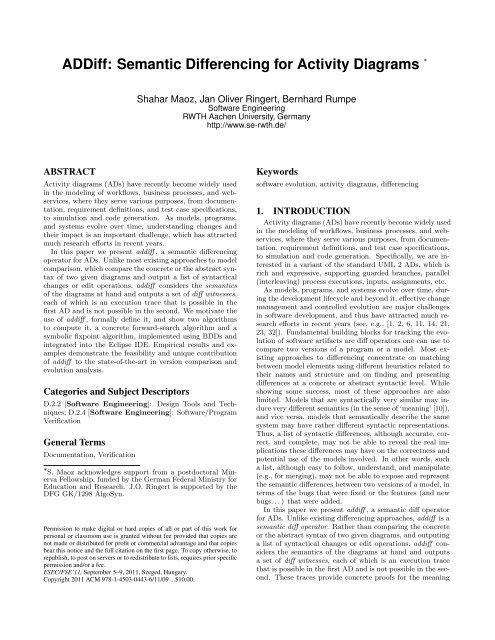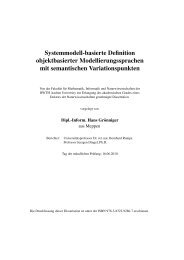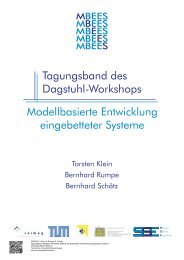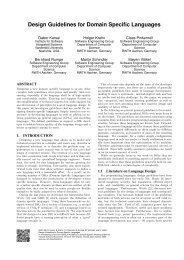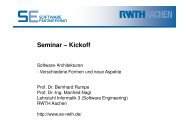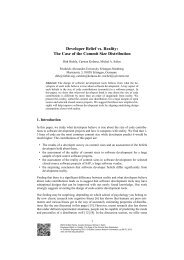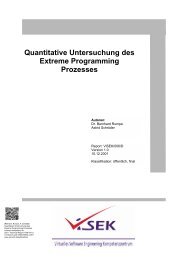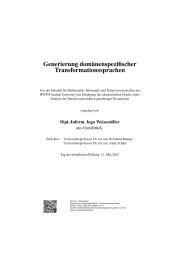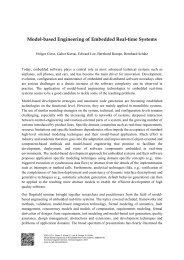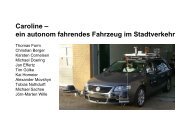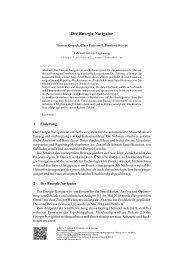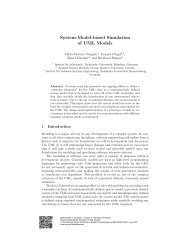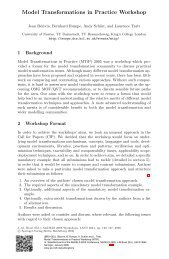Semantic Differencing for Activity Diagrams - Software Engineering
Semantic Differencing for Activity Diagrams - Software Engineering
Semantic Differencing for Activity Diagrams - Software Engineering
You also want an ePaper? Increase the reach of your titles
YUMPU automatically turns print PDFs into web optimized ePapers that Google loves.
ADDiff: <strong>Semantic</strong> <strong>Differencing</strong> <strong>for</strong> <strong>Activity</strong> <strong>Diagrams</strong> ∗<br />
Shahar Maoz, Jan Oliver Ringert, Bernhard Rumpe<br />
<strong>Software</strong> <strong>Engineering</strong><br />
RWTH Aachen University, Germany<br />
http://www.se-rwth.de/<br />
ABSTRACT<br />
<strong>Activity</strong> diagrams (ADs) have recently become widely used<br />
in the modeling of workflows, business processes, and webservices,<br />
where they serve various purposes, from documentation,<br />
requirement definitions, and test case specifications,<br />
to simulation and code generation. As models, programs,<br />
and systems evolve over time, understanding changes and<br />
their impact is an important challenge, which has attracted<br />
much research ef<strong>for</strong>ts in recent years.<br />
In this paper we present addiff , a semantic differencing<br />
operator <strong>for</strong> ADs. Unlike most existing approaches to model<br />
comparison, which compare the concrete or the abstract syntax<br />
of two given diagrams and output a list of syntactical<br />
changes or edit operations, addiff considers the semantics<br />
of the diagrams at hand and outputs a set of diff witnesses,<br />
each of which is an execution trace that is possible in the<br />
first AD and is not possible in the second. We motivate the<br />
use of addiff , <strong>for</strong>mally define it, and show two algorithms<br />
to compute it, a concrete <strong>for</strong>ward-search algorithm and a<br />
symbolic fixpoint algorithm, implemented using BDDs and<br />
integrated into the Eclipse IDE. Empirical results and examples<br />
demonstrate the feasibility and unique contribution<br />
of addiff to the state-of-the-art in version comparison and<br />
evolution analysis.<br />
Categories and Subject Descriptors<br />
D.2.2 [<strong>Software</strong> <strong>Engineering</strong>]: Design Tools and Techniques;<br />
D.2.4 [<strong>Software</strong> <strong>Engineering</strong>]: <strong>Software</strong>/Program<br />
Verification<br />
General Terms<br />
Documentation, Verification<br />
∗ S. Maoz acknowledges support from a postdoctoral Minerva<br />
Fellowship, funded by the German Federal Ministry <strong>for</strong><br />
Education and Research. J.O. Ringert is supported by the<br />
DFG GK/1298 AlgoSyn.<br />
Permission to make digital or hard copies of all or part of this work <strong>for</strong><br />
personal or classroom use is granted without fee provided that copies are<br />
not made or distributed <strong>for</strong> profit or commercial advantage and that copies<br />
bear this notice and the full citation on the first page. To copy otherwise, to<br />
republish, to post on servers or to redistribute to lists, requires prior specific<br />
permission and/or a fee.<br />
ESEC/FSE’11, September 5–9, 2011, Szeged, Hungary.<br />
Copyright 2011 ACM 978-1-4503-0443-6/11/09 ...$10.00.<br />
Keywords<br />
software evolution, activity diagrams, differencing<br />
1. INTRODUCTION<br />
<strong>Activity</strong> diagrams (ADs) have recently become widely used<br />
in the modeling of workflows, business processes, and webservices,<br />
where they serve various purposes, from documentation,<br />
requirement definitions, and test case specifications,<br />
to simulation and code generation. Specifically, we are interested<br />
in a variant of the standard UML 2 ADs, which is<br />
rich and expressive, supporting guarded branches, parallel<br />
(interleaving) process executions, inputs, assignments, etc.<br />
As models, programs, and systems evolve over time, during<br />
the development lifecycle and beyond it, effective change<br />
management and controlled evolution are major challenges<br />
in software development, and thus have attracted much research<br />
ef<strong>for</strong>ts in recent years (see, e.g., [1, 2, 6, 11, 14, 21,<br />
23, 32]). Fundamental building blocks <strong>for</strong> tracking the evolution<br />
of software artifacts are diff operators one can use to<br />
compare two versions of a program or a model. Most existing<br />
approaches to differencing concentrate on matching<br />
between model elements using different heuristics related to<br />
their names and structure and on finding and presenting<br />
differences at a concrete or abstract syntactic level. While<br />
showing some success, most of these approaches are also<br />
limited. Models that are syntactically very similar may induce<br />
very different semantics (in the sense of ‘meaning’ [10]),<br />
and vice versa, models that semantically describe the same<br />
system may have rather different syntactic representations.<br />
Thus, a list of syntactic differences, although accurate, correct,<br />
and complete, may not be able to reveal the real implications<br />
these differences may have on the correctness and<br />
potential use of the models involved. In other words, such<br />
a list, although easy to follow, understand, and manipulate<br />
(e.g., <strong>for</strong> merging), may not be able to expose and represent<br />
the semantic differences between two versions of a model, in<br />
terms of the bugs that were fixed or the features (and new<br />
bugs. . . ) that were added.<br />
In this paper we present addiff , a semantic diff operator<br />
<strong>for</strong> ADs. Unlike existing differencing approaches, addiff is a<br />
semantic diff operator. Rather than comparing the concrete<br />
or the abstract syntax of two given diagrams, and outputing<br />
a list of syntactical changes or edit operations, addiff considers<br />
the semantics of the diagrams at hand and outputs<br />
a set of diff witnesses, each of which is an execution trace<br />
that is possible in the first AD and is not possible in the second.<br />
These traces provide concrete proofs <strong>for</strong> the meaning
of the change that has been done between the two compared<br />
versions and <strong>for</strong> its effect on the use of the models at hand.<br />
We specify ADs using a variant of standard UML 2 ADs [24],<br />
which can also be given textually using a grammar defined<br />
in MontiCore [13, 22]. The syntax of an AD consists of action<br />
nodes, pseudo nodes (initial, final, decision, merge, <strong>for</strong>k,<br />
join), transitions, input variables, and local variables. Transitions<br />
outgoing decision nodes are guarded with Boolean<br />
expressions over the input and local variables. Input variables<br />
values are set by the environment. Action nodes are<br />
labeled with action names and may include assignments to<br />
local variables.<br />
We define the operational semantics of an AD using a<br />
translation to a finite automaton with variables over finite<br />
domains. This induces a trace-based semantics, i.e., a set<br />
of action traces from an initial node to a final node, considering<br />
also the values of input variables. Branches outgoing<br />
<strong>for</strong>k nodes describe parallel executions; they are used to succinctly<br />
specify concurrent interleaving traces. An overview<br />
of the syntax and semantics of our ADs is given in Sect. 3.<br />
Given two ADs, ad 1 and ad 2, addiff (ad 1, ad 2) is roughly<br />
defined as the set of execution traces possible in the first AD<br />
and not possible in the second. As there may be exponentially<br />
many diff traces, we are specifically interested in the<br />
shortest ones, i.e., ones that do not have a prefix which is<br />
a differentiating trace. In addition, we restrict the operator<br />
to provide only a single shortest diff trace <strong>for</strong> each possible<br />
assignment to input variables. To compute addiff we<br />
trans<strong>for</strong>m each of the ADs into a module in SMV, the input<br />
language of the SMV model checker [29]. We then present<br />
two algorithms: a concrete <strong>for</strong>ward-search algorithm and a<br />
symbolic fixpoint algorithm. The second algorithm relies on<br />
the technologies of symbolic model checking [3] in order to<br />
address the state explosion problem of the first. We present<br />
them both in order to allow their comparison. The <strong>for</strong>mal<br />
definition of addiff and the two algorithms are described in<br />
Sect. 4.<br />
We have implemented the two algorithms <strong>for</strong> addiff using<br />
binary decision diagrams (BDDs), and integrated them into<br />
an Eclipse plug-in. The plug-in allows the engineer to compare<br />
two selected ADs, to check if they are equivalent, and<br />
to textually and visually browse the diff witnesses found, if<br />
any. We describe the plug-in implementation in Sect. 5. We<br />
have evaluated the plug-in against all examples shown in this<br />
paper and many other ADs. The results of our evaluation,<br />
including a per<strong>for</strong>mance comparison of the two algorithms,<br />
appear in Sect. 6.<br />
In addition to finding concrete diff witnesses (if any exist),<br />
which demonstrate the meaning of the changes that<br />
were made between one version and another, addiff can be<br />
used to compare two ADs and decide whether one AD semantics<br />
includes the other AD semantics (the latter is a<br />
refinement of the <strong>for</strong>mer), are they semantically equivalent,<br />
or are they semantically incomparable (each allows executions<br />
that the other does not allow). When applied to the<br />
version history of a certain AD, as can be retrieved from<br />
a version repository, such an analysis provides a semantic<br />
insight into its evolution, which is not available in existing<br />
syntactic approaches.<br />
Model and program differencing, in the context of software<br />
evolution, has attracted much research ef<strong>for</strong>ts in recent<br />
years. In contrast to our work, however, most studies in this<br />
internal<br />
assign to<br />
project<br />
register<br />
get welcome pack<br />
manager interview<br />
manager report<br />
authorize payment<br />
!internal<br />
add to<br />
website<br />
hire.v1<br />
assign to<br />
project<br />
internal<br />
assign to<br />
project<br />
register<br />
get welcome pack<br />
assign<br />
keys<br />
manager interview<br />
manager report<br />
authorize payment<br />
!internal<br />
add to<br />
website<br />
hire.v2<br />
assign to<br />
project<br />
Figure 1: Versions 1 and 2 of the hire activity<br />
area present syntactic differencing, at either the concrete or<br />
the abstract syntax level. We discuss related work in Sect. 7.<br />
Finally, our work on semantic differencing does not come<br />
to replace existing syntactic differencing approaches. Rather,<br />
it is aimed at augmenting and complementing existing approaches<br />
with capabilities that were not available be<strong>for</strong>e.<br />
We discuss the combination of syntactic and semantic differencing<br />
as well as other future work directions in Sect. 6.<br />
The next section presents motivating examples demonstrating<br />
the unique features of our work. Sect. 3 provides<br />
preliminary definitions of the AD language syntax and semantics<br />
as used in our work. Sect. 4 introduces addiff and<br />
the two algorithms to compute it. Sect. 5 presents the implementation,<br />
Sect. 6 presents an evaluation and a discussion,<br />
Sect. 7 considers related work, and Sect. 8 concludes.<br />
2. EXAMPLES<br />
We start off with motivating examples <strong>for</strong> semantic differencing<br />
of ADs. The examples are inspired by real-world<br />
ADs we have obtained from several sources (see Sect. 6).<br />
2.1 Example I<br />
AD hire.v1 of Fig. 1 describes a company’s workflow when<br />
hiring a new employee. Roughly, first the employee is registered.<br />
Then, if she is an internal employee, she gets a<br />
welcome package, she is assigned to a project and added to<br />
the company’s computer system (in two parallel activities<br />
branching off a <strong>for</strong>k node), she is interviewed and gets a<br />
manager report, and finally her payments are authorized.<br />
Otherwise (note the decision node at the beginning of the<br />
AD), if the new employee is external, she is only assigned to<br />
a project be<strong>for</strong>e her payments are authorized.<br />
After some time, the company deployed a new security<br />
system and every employee had to receive a key card. A<br />
revised workflow was created, as shown in hire.v2 of Fig. 1.<br />
Later, a problem was found: sometimes employees are<br />
assigned to a project but cannot enter the building since they<br />
do not have a key card yet. This bug was fixed in the next<br />
version, hire.v3, shown in Fig. 2. Finally, the company has<br />
decided that external employees should report to managers<br />
too. Thus, the merge between the two branches <strong>for</strong> internal<br />
and external new employees has moved ‘up’, in between the
egister<br />
hire.v3<br />
register<br />
hire.v4<br />
proj.v1<br />
proj.v2<br />
proj.v3<br />
internal<br />
assign<br />
keys<br />
assign to<br />
project<br />
get welcome pack<br />
add to<br />
website<br />
manager interview<br />
manager report<br />
authorize payment<br />
!internal<br />
assign to<br />
project<br />
internal<br />
get welcome pack<br />
assign<br />
keys<br />
assign to<br />
project<br />
add to<br />
website<br />
manager interview<br />
manager report<br />
authorize payment<br />
!internal<br />
assign to<br />
project<br />
Figure 2: Versions 3 and 4 of the hire activity<br />
interview and the report nodes. The resulting 4th version<br />
of the workflow, hire.v4, is shown in Fig. 2<br />
Given these four versions of the activity, an evolution<br />
analysis is called <strong>for</strong>. Comparing hire.v1 and hire.v2 using<br />
addiff reveals that they are semantically incomparable:<br />
some executions of hire.v1 are no longer possible in hire.v2,<br />
and some executions of hire.v2 were not possible in hire.v1.<br />
Moreover, it reveals that handling of internal employees has<br />
changed, but handling of external ones remained the same<br />
between the two versions.<br />
Comparing hire.v2 and hire.v3 reveals that the latter<br />
is a refinement of the <strong>for</strong>mer: hire.v3 has removed some<br />
traces of hire.v2 and did not allow new traces. In particular,<br />
addiff (hire.v2, hire.v3) shows that the trace where a<br />
person is assigned to a project be<strong>for</strong>e she gets a key card<br />
was possible in hire.v2 and is no longer possible in hire.v3,<br />
i.e., it demonstrates that the bug was fixed.<br />
Finally, comparing hire.v3 and hire.v4 using addiff reveals<br />
that although hiring of external employees has changed<br />
between the two versions, hiring of internal employees did<br />
not: addiff (hire.v3, hire.v4) contains a single trace, where<br />
the employee is external, not internal. That is despite the<br />
syntactic change of moving the merge node from after to<br />
be<strong>for</strong>e the report node, which is also part of the trace of<br />
handling internal employees.<br />
2.2 Example II<br />
AD proj.v1 of Fig. 3 describes a company’s workflow when<br />
receiving a new project. Roughly, first the project is registered.<br />
Then, the required work is defined, the office work is<br />
done, the clients work is done, and a report is written. If<br />
the project is of type small, the activity continues to final<br />
report and is completed. If the project is of type large, a<br />
second phase of the required work is defined, the office work<br />
is done, the clients work is done, and a report is written,<br />
be<strong>for</strong>e continuing to the final report and completion.<br />
After some time, the activity designer suggested a refactoring:<br />
instead of the explicit duplication of the four work<br />
actions in the diagram, a loop will be defined. The designer<br />
added a local variable c, which is initialized when the project<br />
is registered and is incremented when writing the report.<br />
register<br />
project<br />
define<br />
work<br />
office<br />
work<br />
clients<br />
work<br />
report<br />
final<br />
report<br />
define<br />
work<br />
office<br />
work<br />
clients<br />
work<br />
report<br />
type=large<br />
type=small<br />
register<br />
project<br />
C=0<br />
define<br />
work<br />
office<br />
work<br />
clients<br />
work<br />
report<br />
c=c+1<br />
c
• V inp is a (possibly empty) set of immutable input variables<br />
over finite domains.<br />
• V loc is a (possibly empty) set of local variables over<br />
finite domains.<br />
• AN is a set of action nodes an 1, . . . , an k . Each action<br />
node an is labeled with an action name acname(an) =<br />
ac ∈ A, and a (possibly empty) set of assignment expressions<br />
to the variables in V loc .<br />
• P N is a set of pseudo nodes, consisting of initial nodes<br />
P N init , final nodes P N fin , decision nodes P M dec ,<br />
merge nodes P N mer , <strong>for</strong>k nodes P N <strong>for</strong>k , and join<br />
nodes P N join .<br />
• T is a set of transitions of the <strong>for</strong>m t = 〈n src, n trg, guard〉<br />
where n src, n trg ∈ (AN ∪ P N) and guard is a Boolean<br />
expression over the variables in V inp ∪ V loc . Unless<br />
n src is a decision node, guard = true.<br />
We do not <strong>for</strong>mally capture here obvious well-<strong>for</strong>medness<br />
rules and context conditions such as: initial nodes have no<br />
incoming transitions, final nodes have no outgoing transitions,<br />
<strong>for</strong>k nodes must be followed by join nodes to remove<br />
all concurrency when reaching a final node, actions should<br />
not repeat in different <strong>for</strong>ked branches, etc.<br />
In addition, we assume that the Boolean expressions used<br />
as guards on transitions outgoing decision nodes are semantically<br />
exclusive, that is, no assignment to the diagram variables<br />
makes more than one of them true. Thus, the input<br />
variables provide external non-determinism, while except <strong>for</strong><br />
<strong>for</strong>ked branches, our ADs are internally deterministic.<br />
We consider two concrete syntax definitions <strong>for</strong> ADs: a<br />
concrete visual syntax based on UML 2 ADs and a concrete<br />
textual syntax defined using MontiCore [13, 22]. We omit<br />
the concrete syntax definitions from this paper.<br />
The implementation we present in Sect. 5 supports a subset<br />
of full UML 2 ADs: it supports action nodes and pseudo<br />
nodes: initial, final, <strong>for</strong>k, join, decision and merge; each<br />
AD has exactly one initial node but may have multiple final<br />
nodes. For simplicity reasons but without loss of generality,<br />
in our implementation no two pseudo nodes can follow each<br />
other directly. In addition, local and input variables have<br />
to be declared as such in the first action node; all variables’<br />
finite domains need to be given as SMV types or enumerations;<br />
and each local variable needs to be assigned a value<br />
in the first action node. We support Boolean guards specified<br />
in the rich SMV expression language [4]. Assignments<br />
to local variables can be made from any action node using<br />
values from SMV expressions.<br />
3.2 AD Language <strong>Semantic</strong>s<br />
We distinguish operational semantics and trace-based semantics.<br />
The operational semantics is based on the definition<br />
of a state machine step, taking the AD from one state<br />
to another, where a state consists of a set of current action<br />
nodes and an assignment to all input and local variables.<br />
The main idea of our operational semantics is to conceptually<br />
translate each ad ∈ AD into a finite state machine<br />
(FSM). Each state is a configuration containing the values<br />
of all local variables and input variables (recall that variables<br />
range over finite domains), the executed action, and<br />
some extra variables with in<strong>for</strong>mation on the control flow of<br />
the AD. Based on this state and evaluated guards possible<br />
transitions are computed that lead to the next state with an<br />
executed action, possibly changed local variables values, and<br />
a new configuration of the control flow tracking variables.<br />
We <strong>for</strong>mally define the operational semantics using a trans<strong>for</strong>mation<br />
of an AD to a module of SMV, the language of the<br />
SMV model checker [20, 29]. Our translation is inspired by<br />
the work of [7], but extends this previous translation with<br />
support <strong>for</strong> data. The complete translation, together with a<br />
detailed example, appears in a separate document [17].<br />
Local variables assist the AD engineer together with guards<br />
to control the execution sequences of actions, e.g., by defining<br />
loops or activating/disabling branches of decision nodes.<br />
Input variables, in contrast to local variables, are initialized<br />
by the environment and do not change during the run of<br />
an AD. The runs of two ADs are compared with the same<br />
input, i.e., where common input variables of both ADs have<br />
the same values. We consider all possible input values of<br />
both ADs when comparing them.<br />
Our semantics of ADs is rather expressive: it considers<br />
values of input variables to be set by the environment (external<br />
non-determinism). However, we only support internal<br />
non-determinism through interleaved execution of <strong>for</strong>ked<br />
branches, and not through non-deterministic decision nodes;<br />
the current configuration and the next executed action determine<br />
the next configuration. Thus, <strong>for</strong> each assignment<br />
to the input variables there could be many possible executions<br />
due to the interleaving semantics of <strong>for</strong>k nodes.<br />
We define a trace-based semantics that is induced by the<br />
operational semantics. Traces are sequences of states from<br />
the state space of the AD’s FSM.<br />
Definition 1 (AD state). A state of an AD ad is an<br />
assignment to all variables defined in the VAR section of its<br />
SMV module. This includes the last executed node acnode<br />
and its action name ac, the values of variables v ∈ ad.V inp ∪<br />
ad.V loc and the values of control flow tracking variables.<br />
AD states have a finite number of possible successor states<br />
that can be reached within one step. By construction, each<br />
such step executes an action or reaches a final node. We<br />
define the successors of an AD state s as successors(s).<br />
Definition 2 (Successor states). For every AD state<br />
s, successors(s) is the set of AD states reachable from s in<br />
one step of the SMV module.<br />
Each run of an AD starts with an initial state in the initial<br />
node. A sequence of successor states that describe a legal<br />
execution of the AD’s FSM is a trace. A trace from the<br />
initial to a final node of the AD is an accepting trace.<br />
Definition 3 (AD traces). A sequence of AD states<br />
tr = s 0, s 1, . . . , s k of AD ad with s i+1 ∈ successors(s i) and<br />
s 0.acnode ∈ ad.P N init is called a trace. The set of all traces<br />
of an AD ad is denoted by traces(ad). A trace is called an<br />
accepted trace if its last state’s node is a final node of the<br />
AD. The set of all accepted traces of an AD ad is denoted<br />
by acceptedT races(ad).<br />
4. ADDIFF<br />
4.1 Definitions<br />
Given two AD states, s 1 ∈ ad 1 and s 2 ∈ ad 2, we say that<br />
s 1 and s 2 are corresponding, iff the action names and values<br />
of equally named input variables of the two states are the<br />
same. Formally:
Definition 4 (corresponding states). Given two ADs,<br />
ad 1 and ad 2, and two states s 1 ∈ ad 1 and s 2 ∈ ad 2, we say<br />
that s 1 and s 2 are corresponding, denoted s 1 ∼ s 2, iff the<br />
following conditions hold:<br />
1. s 1.ac = s 2.ac;<br />
2. ∀v ∈ V inp<br />
1 ∩ V inp<br />
2 , s 1.val(v) = s 2.val(v).<br />
The definition of corresponding states punctually extends to<br />
traces in a natural way.<br />
Given two ADs, a trace of the first AD is a diff trace<br />
iff there exists a trace of the second AD where all states<br />
except the last correspond to the states of the first trace,<br />
but the last state of the first trace does not correspond to<br />
any possible successor state of the second trace. Formally:<br />
Definition 5 (diff trace). Given two ADs, ad 1 and<br />
ad 2, a diff trace is a sequence of states tr 1 = s 0 1, s 1 1, . . . , s k 1, s k+1<br />
1<br />
s.t.<br />
1. tr 1 ∈ traces(ad 1)<br />
2. ∃tr 2 = s 0 2, s 1 2, . . . , s k 2 s.t. tr 2 ∈ traces(ad 2)<br />
∧∀i, 0 ≤ i ≤ k, s i 1 ∼ s i 2<br />
∧∄s k+1<br />
2 s.t. s k+1<br />
2 ∼ s k+1<br />
1 ∧s 0 2, s 1 2, . . . , s k 2, s k+1<br />
2 ∈ traces(ad 2).<br />
tr 2 is called a corresponding diff trace of tr 1.<br />
We denote the set of all diff traces of ad 1 vs. ad 2 by<br />
diffTraces(ad 1, ad 2). Note that diffTraces is not symmetric.<br />
We are now ready to present the definition of addiff . Note<br />
that we are interested only in shortest diff traces: we restrict<br />
addiff to diff traces that do not have another diff trace as<br />
prefix. Moreover, to make the set addiff succinct, <strong>for</strong> each<br />
initial state of ad 1, if there is a diff trace that starts at this<br />
initial state, we want only one such trace to be in addiff .<br />
Formally:<br />
Definition 6 (addiff). addiff(ad 1, ad 2) is a subset<br />
of diffTraces(ad 1, ad 2) s.t.<br />
1. ∀tr ∈ addiff(ad 1, ad 2), ∄tr ′ s.t. tr ′ ∈ addiff(ad 1, ad 2) ∧<br />
tr ′ ❁ tr;<br />
2. ∀s 0 1 ∈ ad 1.initials,<br />
if ∃tr ∈ diffTraces(ad 1, ad 2) s.t. tr starts at s 0 1<br />
then |{tr ∈ addiff(ad 1, ad 2)|tr starts at s 0 1}| = 1.<br />
Finally, note that we do not require that diff traces can be<br />
extended into accepting traces (ones that end at a final node,<br />
see Def. 3). For an alternative definition, see the discussion<br />
in Sect. 6.<br />
4.2 Computing ADDiff<br />
We present two different algorithms, a concrete <strong>for</strong>wardsearch<br />
algorithm and a symbolic fixpoint algorithm.<br />
4.2.1 Algorithm I<br />
We compute addiff (ad 1, ad 2) using a BFS-like traversal<br />
of the state space of ad 1 that is used to ‘guide’ a BFS-like<br />
traversal of the state space of ad 2. Roughly, the algorithm<br />
uses a queue <strong>for</strong> corresponding states-pairs that have been<br />
reached but whose successors have not yet been traversed<br />
(the use of the queue guarantees that shortest paths will be<br />
found first). It also maintains a list of visited corresponding<br />
state-pairs and a list of rejecting state-pairs. Initially, all<br />
corresponding initial states-pairs are inserted in the queue,<br />
and all initial states of ad 1 that do not have a corresponding<br />
initial state in ad 2 are added to the list of rejecting statepairs.<br />
Then, <strong>for</strong> each state-pair taken out from the queue,<br />
the algorithm checks that each successor state of the first element<br />
in the state-pair (the state in ad 1), has a corresponding<br />
successor state of the second element in the state-pair (the<br />
state in ad 2). Every corresponding pair found, if not visited<br />
be<strong>for</strong>e, is inserted to the queue. If no corresponding successor<br />
is found, we know we have found the end state of a<br />
(shortest) diff trace: we add it to the list of rejecting statepairs<br />
and we remove from the queue all the state-pairs whose<br />
input variables values <strong>for</strong> ad 1 are the same as the ones <strong>for</strong><br />
the state we have found. When the queue is empty, the list<br />
of visited state-pairs is used to construct the traces leading<br />
back from the rejecting state-pairs to the initial states.<br />
A pseudo-code <strong>for</strong> the algorithm is given in Proc. 1, which<br />
uses Proc. 2 and 3. We describe these procedures below.<br />
The algorithm uses a structure P air made of two pairs<br />
of states: predecessor and current state in ad 1, pre 1 and<br />
cur 1, and predecessor and current state in ad 2, pre 2 and<br />
cur 2. Two pairs are considered equal if their current states<br />
are equal (ignoring predecessor states). P air is used to keep<br />
track of pairs of visited states, one state from each AD, and<br />
of their predecessors, as found during the traversal of the<br />
state space. The predecessors are used in the reconstruction<br />
of the traces from the lists of rejecting and visited pairs.<br />
Proc. 1 defines the required structures (l. 1-3): a queue<br />
of pairs, a list of visited pairs, a list of rejecting pairs, and a<br />
list of list of pairs, which will hold the computed diff traces.<br />
It iterates over all initial states of ad 1, and <strong>for</strong> each of them,<br />
looks <strong>for</strong> a corresponding initial state in ad 2. If a corresponding<br />
state is found, the new pair is inserted to the queue and<br />
to the visited list (l. 8). If no corresponding state is found,<br />
a pair where only the ad 1 current state is defined is added<br />
to the list of rejecting state pairs (l. 13).<br />
After initialization, the algorithm calls traverse (Proc. 2),<br />
to iterate on the queue until it is empty. For each dequeued<br />
pair, the procedure iterates over all the successors of its current<br />
ad 1 state. For each successor, it tries to find a corresponding<br />
successor of the current ad 2 state. If a corresponding<br />
state is found, the new pair is inserted to the queue and<br />
to the visited list (l. 9). If no corresponding state is found,<br />
a pair where only the ad 1 current state is defined is added to<br />
the list of rejecting states (l. 15). In addition, all state-pairs<br />
whose current ad 1 state agrees with the current ad 1 state in<br />
the rejecting pair on input variables, are removed from the<br />
queue (l. 16-17). This ensures that no further searching of<br />
diff traces outgoing the same initial state will be done.<br />
Finally, trace (Proc. 3) is used to reconstruct the traces<br />
leading from initial states to the rejecting states that have<br />
been found. The procedure works backward: it starts from<br />
the rejecting pairs and uses the predecessor states to build<br />
the required traces, from the rejecting states back to the<br />
initial states, using the pairs saved in the visited list. It<br />
continues as long as their predecessor states are defined, i.e.,<br />
as long as it has not reached an initial state.<br />
4.2.2 Algorithm II<br />
We compute addiff (ad 1, ad 2) using a symbolic least-fixpoint<br />
algorithm. The algorithm relies on the technologies of symbolic<br />
model checking [3], and is inspired by the classic fixpoint<br />
algorithm to compute a maximal simulation relation,<br />
and, more specifically, by the synthesis algorithm of [26],
Procedure 1 concrete-addiff(ad 1,ad 2)<br />
1: define queueP airs as queue of P air<br />
2: define visited, rejects as list of P air<br />
3: define traces as list of lists of P air<br />
4: <strong>for</strong> all ini 1 ∈ ad 1 .initials do<br />
5: foundCorresponding ← false<br />
6: <strong>for</strong> all ini 2 ∈ ad 2 .initials do<br />
7: if corresponding(ini 1 , ini 2 ) then<br />
8: add P air(−, ini 1 , −, ini 2 ) to queueP airs, visited<br />
9: foundCorresponding ← true<br />
10: end if<br />
11: end <strong>for</strong><br />
12: if not foundCorresponding then<br />
13: add P air(−, ini 1 , −, −) to rejects<br />
14: end if<br />
15: end <strong>for</strong><br />
16: visited, rejects ← traverse(ad 1 ,ad 2 )<br />
17: traces ← trace(visited,rejects)<br />
18: return traces<br />
Procedure 2 traverse(ad 1,ad 2)<br />
1: while queueP airs is not empty do<br />
2: p ← pair from queueP airs<br />
3: <strong>for</strong> all suc 1 ∈ p.cur 1 .successors do<br />
4: foundCorresponding ← false<br />
5: <strong>for</strong> all suc 2 ∈ p.cur 2 .successors do<br />
6: if corresponding(suc 1 , suc 2 ) then<br />
7: newP air ← P air(p.cur 1 , suc 1 , p.cur 2 , suc 2 )<br />
8: if newP air /∈ visited then<br />
9: add newP air to queueP airs, visited<br />
10: end if<br />
11: foundCorresponding ← true, break<br />
12: end if<br />
13: end <strong>for</strong><br />
14: if not foundCorresponding then<br />
15: add P air(p.cur 1 , suc 1 , p.cur 2 , −) to rejects<br />
16: remove all pair from queueP airs<br />
17: where p.cur 1 .inputs = pair.cur 1 .inputs<br />
18: end if<br />
19: end <strong>for</strong><br />
20: end while<br />
21: return visited, rejects<br />
where intermediate values from the fixpoint computation are<br />
used in the construction of a concrete winning strategy.<br />
Roughly, our symbolic algorithm starts with a representation<br />
of all non-corresponding states. It then moves ‘backward’,<br />
and adds to the current set of states, states from<br />
which there exists a successor in ad 1 such that <strong>for</strong> all successors<br />
in ad 2, the resulting successor pair is in the current<br />
set of states. Most importantly, to help in the construction<br />
of diff traces later, at each step backward, the algorithm remembers<br />
the newly computed set of added states. The steps<br />
‘backward’ continue until reaching a least fixpoint, that is,<br />
until no more states are added.<br />
When the fixpoint is reached, the algorithm checks whether<br />
the last computed set (the fixpoint set) includes initial states.<br />
For each such initial state, if any, the algorithm uses the<br />
sets of states computed during the backward steps to move<br />
<strong>for</strong>ward (from the minimal position it can start from) and<br />
construct shortest diff traces.<br />
We present our algorithm in general set notation, with the<br />
set-operations of union, intersection, and complementation.<br />
In the pseudo code below, sets with no subscript are sets<br />
of states over the union of all variables from ad 1 and ad 2.<br />
For i ∈ {1, 2}, sets with subscript i are sets of states over<br />
Procedure 3 trace(visited,rejects)<br />
1: <strong>for</strong> all rejectingP air ∈ rejects do<br />
2: define tr as list of P air<br />
3: curP air ← rejectingP air<br />
4: while curP air is not null do<br />
5: add curP air to tr<br />
6: if curP air.pred 1 is not null then<br />
7: curP air ←<br />
getV isited(curP air.pred 1 , curP air.pred 2 , visited)<br />
8: else<br />
9: break<br />
10: end if<br />
11: end while<br />
12: add tr to traces<br />
13: end <strong>for</strong><br />
14: return traces<br />
Procedure 4 symbolic-addiff(ad 1,ad 2)<br />
1: define traces as list of lists of Set<br />
2: define mem as array of Set<br />
3: mem ← least-fixpoint-with-mem(ad 1 ,ad 2 )<br />
4: if mem.last ∩ initials ≠ ∅ then<br />
5: traces ← build-traces-from-mem(ad 1 ,ad 2 ,mem)<br />
6: end if<br />
7: return traces<br />
the variables of ad i. The operator S| adi is used to restrict<br />
the variables of the set S to the variables of ad i (all other<br />
variables are existentially quantified out). The operation<br />
choose one relates to choosing a single element from the<br />
relevant set (a single concrete assignment to the variables).<br />
The sets corr and initials are the set of corresponding states<br />
and the set of joint initial states, respectively. When intersecting<br />
a set S i over the variables of ad i with a set S over<br />
the union of all variables from both ADs, the result is a set<br />
over the union of variables where the variables of ad i agree<br />
with their possible assignments in the set S i.<br />
In the implementation, the sets are represented using BDDs.<br />
A pseudo-code <strong>for</strong> the algorithm is given in Proc. 4, which<br />
uses Proc. 5 and 6.<br />
Note that in the final iteration of the loop in Proc. 6,<br />
reached with i = 1, the assignment to next 2 is guaranteed<br />
to set next 2 ← ∅, because the first location in the memory<br />
array equals corr. This guarantees that the last state in each<br />
diff trace assigns no values to the variables of ad 2: indeed,<br />
the last ad 1 state in the trace should have no corresponding<br />
ad 2 state in the trace.<br />
If the user is interested only in checking the existence of<br />
differences but not in the set of all witnesses, we can stop<br />
the steps backward as soon as the set of added states includes<br />
an initial state (by checking whether p ∩ initials = ∅<br />
already after line 9 in Proc. 5). In some cases, as our evaluation<br />
shows (see Sect. 6), this is indeed much faster than<br />
waiting <strong>for</strong> the fixpoint to be reached and <strong>for</strong> all traces to be<br />
enumerated. Note that trace enumeration is not symbolic<br />
and thus may not scale well.<br />
Finally, <strong>for</strong> both algorithms, the concrete and the symbolic,<br />
correctness and completeness are proved by induction<br />
on the length of the traces and rely on the fact that the ADs<br />
are internally deterministic.<br />
5. IMPLEMENTATION AND USES<br />
We have implemented addiff and integrated it into a prototype<br />
Eclipse plug-in. The input <strong>for</strong> the implementation are
Procedure 5 least-fixpoint-with-mem(ad 1,ad 2)<br />
1: define mem as array of Set<br />
2: define p, z, oldz as Set<br />
3: define i as number<br />
4: z ← corr, oldz ← ∅<br />
5: i ← 0<br />
6: mem[i] ← z<br />
7: while z ≠ oldz do<br />
8: oldz ← z<br />
9: p ← { (s 1 , s 2 ) | s 1 ∈ ad 1 ∧s 2 ∈ ad 2 ∧∃suc 1 ∈ s 1 .successors<br />
s.t. ∀suc 2 ∈ s 2 .successors (suc 1 , suc 2 ) ∈ z}<br />
10: z ← z ∪ p<br />
11: i ← i + 1<br />
12: mem[i] ← z<br />
13: end while<br />
14: return mem<br />
Procedure 6 build-traces-from-mem(ad 1,ad 2,mem)<br />
1: <strong>for</strong> all ini 1 ∈ (mem.last ∩ initials)| ad1 do<br />
2: define tr as list of Set<br />
3: find minimal j s.t. ini 1 ∩ mem[j] ≠ ∅<br />
4: ini 2 ← choose one from (ini 1 ∩ initials)| ad2<br />
5: CS ← CombinedState(ini 1 , ini 2 )<br />
6: add CS to tr<br />
7: <strong>for</strong> i = j down to 1 do<br />
8: next 1 ← choose one from<br />
9:<br />
(CS| ad1 .successors ∩ mem[i − 1]| ad1 )<br />
next 2 ← choose one from<br />
10:<br />
(next 1 ∩corr∩mem[i−1])| ad2 ∩(CS| ad2 .successors)<br />
CS ← CombinedState(next 1 , next 2 )<br />
11: add CS to tr<br />
12: end <strong>for</strong><br />
13: add tr to traces<br />
14: end <strong>for</strong><br />
15: return traces<br />
UML 2 ADs, drawn and parsed using Eclipse UML 2 APIs.<br />
The plug-in trans<strong>for</strong>ms the input ADs into SMV <strong>for</strong>mat. It<br />
then computes addiff via the APIs of JTLV [27], a framework<br />
<strong>for</strong> the development of verification algorithms, using<br />
bdd-based symbolic mechanisms. The underlying BDD package<br />
used is CUDD [30]. Both algorithms are implemented<br />
and the engineer can choose which one to use. The plug-in,<br />
together with all the example ADs we used in the evaluation,<br />
is available from [28].<br />
5.1 Browsing diff traces<br />
The plug-in allows the engineer to compare two selected<br />
ADs, and to textually and visually browse the diff traces<br />
found, if any. Fig. 4 shows an example screenshot, where the<br />
engineer has selected to compare diagrams hire.v2 (top) and<br />
hire.v4 (middle) (presented in Sect. 2), and is browsing one<br />
of the two diff traces that were found. Note the numbered<br />
and highlighted action nodes, which visually show the states<br />
along one of the diff traces that the plug-in has found: the<br />
trace register, get welcome pack, assign to project is<br />
possible in hire.v2 and is not possible in hire.v4.<br />
A textual representation of the diff trace is displayed on<br />
the lower pane. This representation of a trace is a special<br />
case of a model-based trace (see [15, 16]). It shows the details<br />
of each state in the current diff trace in both ADs, consisting<br />
of the action name and all variable values. This textual<br />
representation is important because it is more detailed and<br />
because it scales better than the visual representation when<br />
handling long traces.<br />
Clicking Check Difference checks whether the semantics<br />
of the second AD includes the semantics of the first.<br />
Clicking Compute Witnesses computes the diff traces and<br />
shows a message telling the engineer how many traces were<br />
found, if any. The Next and Previous buttons browse <strong>for</strong><br />
the next and previous diff traces. The Switch Direction<br />
button switches the order of comparison. The Concrete and<br />
Symbolic buttons toggle between the two addiff algorithms.<br />
5.2 High-level evolution analysis<br />
Another application enabled by the plug-in is high-level<br />
evolution analysis. The plug-in supports a compare command:<br />
given two ADs, ad 1 and ad 2, the command checks<br />
whether one AD is a refinement of the other, are the two<br />
ADs semantically equivalent, or are they semantically incomparable<br />
(each allows traces the other does not allow).<br />
Formally, compare(ad 1, ad 2) returns one of four answers:<br />
< if addiff (ad 1, ad 2) = ∅ and addiff (ad 2, ad 1) ≠ ∅<br />
> if addiff (ad 1, ad 2) ≠ ∅ and addiff (ad 2, ad 1) = ∅<br />
≡ if addiff (ad 1, ad 2) = ∅ and addiff (ad 2, ad 1) = ∅<br />
if addiff (ad 1, ad 2) ≠ ∅ and addiff (ad 2, ad 1) ≠ ∅<br />
Given a reference to a series of historical versions of an<br />
AD, as can be retrieved from the AD’s entry in a revision<br />
repository (e.g., SVN), the plug-in can use the compare command<br />
to compute a high-level analysis of the evolution of<br />
the AD: which new versions have introduced new behaviors<br />
relative to their predecessors, which new versions have eliminated<br />
behaviors relative to their predecessors, and which<br />
new versions included only syntactical changes that have not<br />
changed the semantics of the AD. For example, applying this<br />
evolution analysis to the ADs presented in Sect. 2 reveals:<br />
hire.v1 hire.v2, hire.v2 > hire.v3, hire.v3 hire.v4,<br />
proj.v1 ≡ proj.v2 and proj.v2 < proj.v3.<br />
6. EVALUATION AND DISCUSSION<br />
6.1 Evaluation<br />
We have tested our implementations of addiff against<br />
synthetic ADs and against real-world ADs, selected and<br />
adapted from several sources: (1) selected ADs from a library<br />
of more than 700 business process models by IBM [8]<br />
(our selection is representative of the size and complexity<br />
statistics of the models in this library, as described in [8]),<br />
(2) several models (with version history) we have obtained<br />
from Nokia Corp., Test Management, and (3) from a third<br />
company (which requested to remain unnamed). The IBM<br />
models did not include version history in<strong>for</strong>mation so we<br />
have manually added some mutations (e.g., action additions<br />
and removals, change of branching conditions). The models<br />
from Nokia and the third company included version history.<br />
All the models we have used are available in a dedicated<br />
evaluation project that is attached to the plug-in so that all<br />
experiments we report on below can be reproduced. The<br />
experiments were per<strong>for</strong>med on a regular laptop computer,<br />
Intel Dual Core CPU, 2.8 GHz, with 4 GB RAM, running<br />
Windows Vista. Running times are reported in milliseconds.<br />
6.1.1 Quantitative evaluation<br />
Table 1 (upper part) shows results from executing addiff<br />
over the examples presented in Sect. 2 and selected realworld<br />
ADs from the sources mentioned above. For each<br />
two versions we report the number of nodes, the size of the
Figure 4: The prototype plug-in, comparing two ADs, hire.v2 and hire.v4. The highlighted and numbered<br />
nodes show one of the two diff traces found by addiff : <strong>for</strong> an internal employee, the trace register, get<br />
welcome pack, and assign to project is possible in hire.v2 and is not possible in hire.v4. A detailed textual<br />
representation of this diff trace is provided in the lower pane.<br />
(reachable) state space, the number of diff traces found, the<br />
length of the shortest and longest diff traces found, and the<br />
times it took the concrete and the symbolic algorithms to<br />
(1) decide the existence of at least one diff trace and (2) to<br />
compute all diff traces.<br />
To examine scalability, we used synthetic ADs of comparable<br />
or much larger size (in both number of action nodes<br />
and state space), divided into two families of ‘worst case’<br />
ADs: a family of ‘<strong>for</strong>king ADs’ with concurrent section of<br />
length L and growing width W , and a family of ‘linear ADs’<br />
with two linear fragments of length L seperated by a single<br />
decision over a domain of increasing size D. The lower part<br />
of Table 1 shows results from executing addiff on these ADs,<br />
with versions created using synthetic mutations: replacing,<br />
deleting, or moving of actions.<br />
These results suggest the following observations. First,<br />
on small ADs, the two algorithms show similar per<strong>for</strong>mance<br />
results. However, as the ADs grow, the symbolic algorithm<br />
per<strong>for</strong>ms much better than the concrete one. On the largest<br />
ADs, the concrete algorithm per<strong>for</strong>mance is not practical<br />
while the symbolic algorithm stays within less than 4 seconds<br />
(on all real-world ADs). We believe this means addiff can<br />
be used by engineers in practice.<br />
Second, checking <strong>for</strong> the existence of a difference is sometimes<br />
much faster than listing all diff traces, specifically<br />
when there are many diff traces or when the shortest one<br />
is much shorter than the longest one. Again, as the ADs<br />
grow, the symbolic algorithm outper<strong>for</strong>ms the concrete one.<br />
That said, we do have synthetic ‘worst case’ examples<br />
where the symbolic algorithm is not better than the concrete<br />
one. This happens, e.g., in the extreme case of a long linear<br />
AD with no branches or <strong>for</strong>ks. It also happens when the<br />
number of diff traces is large and enumerating them takes<br />
much time. Moreover, the specific change done between the<br />
two ADs may have significant effect on both algorithms’<br />
per<strong>for</strong>mance: two very syntactically similar mutations (e.g.,<br />
a rename in one branch or in another), may induce dramatic<br />
changes in the number of diff traces. Complete results of and<br />
models used in our experiments are available from [28].<br />
6.1.2 Qualitative evaluation<br />
As mentioned above, we have obtained several real-world<br />
ADs with version history in<strong>for</strong>mation from Nokia Corp.,<br />
Test Management, and from another company. We used<br />
our plug-in to compare different versions and analyze the<br />
evolution of these ADs. We have also used other publicly<br />
available diff tools (Eclipse default differencing mechanism<br />
and EMFCompare [5]) in the analysis and compared them<br />
with addiff . Screen captures from our analysis sessions are<br />
available from [28].<br />
Classical textual differencing was, as expected, not helpful<br />
in comparing the ADs, as it merely compared their XMI<br />
representations. EMFCompare [5] reported correct addition<br />
and removal of actions and transitions and presented them<br />
on the abstract syntax tree structures of the two ADs. Still,<br />
this was not so helpful in understanding the differences between<br />
the ADs because (1) the comparison was done on<br />
the AST level and abstracted the control flow away, and<br />
(2) the results were shown on the AST and not on the<br />
ADs themselves: we saw the changes in the AST and had<br />
to manually search <strong>for</strong> their concrete manifestation on the<br />
ADs. Moreover, in many cases, the list of additions and<br />
removals reported by EMFCompare was too large to be useful,<br />
e.g., when comparing hire.v2 and hire.v4 (presented<br />
earlier), EMFCompare reported 23 additions and removals,<br />
much more than one would intuitively expect <strong>for</strong> these two
AD names # Nodes Reachable state spaces # Wit. Shortest/Longest Alg. I decide/all (ms) Alg. II decide/all (ms)<br />
hireV1/hireV2 14/15 18/26 1 6/6 69/80 57/75<br />
hireV2/hireV3 15/15 26/21 1 4/4 53/69 53/68<br />
hireV3/hireV4 15/15 21/22 1 4/4 50/60 54/61<br />
projV1/projV2 13/9 22/22 0 0/0 52/52 44/47<br />
projV2/projV3 9/11 22/28 0 0/0 53/53 41/50<br />
IBM3561-1/2 18/18 121/122 2 7/61 105/173 113/243<br />
IBM2905-1/2 39/39 2680/2680 80 9/10 3010/7360 911/3667<br />
IBM2568-1/2 50/50 3834/3834 128 5/5 2725/4503 1328/3508<br />
IBM0863-1/2 23/23 1136/1136 76 5/8 1186/2970 200/844<br />
IBM3735-1/2 16/15 118/99 5 4/9 57/101 57/89<br />
IBM2557-1/2 17/15 275/175 6 7/7 66/95 74/120<br />
NokiaAV1/2 15/17 38/44 4 4/9 48/67 47/71<br />
NokiaAV2/3 17/23 44/96 4 7/7 71/101 76/111<br />
NokiaAV3/4 23/23 96/76 4 7/7 84/119 98/137<br />
AnonV1/2 15/15 37/37 2 6/6 50/64 47/61<br />
AnonV2/3 15/19 37/80 1 8/8 67/72 57/70<br />
<strong>for</strong>king(W1/L6)/mutated 12/12 11/11 1 9/9 57/79 49/58<br />
<strong>for</strong>king(W2/L6)/mutated 18/18 89/89 1 15/15 121/135 100/138<br />
<strong>for</strong>king(W3/L6)/mutated 24/24 887/887 1 21/21 1293/1332 496/667<br />
<strong>for</strong>king(W4/L6)/mutated 30/30 8237/8237 1 27/27 88878/89399 5892/7757<br />
lbl(L12/D16)/mutated 34/34 496/496 1 15/15 367/608 373/507<br />
lbl(L12/D32)/mutated 34/34 992/992 1 15/15 698/1377 678/895<br />
lbl(L12/D64)/mutated 34/34 1984/1984 1 15/15 2242/4874 1651/2161<br />
lbl(L12/D128)/mutated 34/34 3968/3968 1 15/15 9867/23529 5789/6685<br />
Table 1: Results from computing addiff <strong>for</strong> selected example, real-world, and synthetic ADs (see Sect. 6.1.1).<br />
For each two versions we report the number of nodes, the reachable state space, the number of diff traces<br />
found, the length of the shortest and longest diff traces found, and the times it took the concrete and the<br />
symbolic algorithms to (1) decide the existence of at least one diff trace and (2) to compute all diff traces.<br />
ADs (addiff reports a total of three diff witnesses <strong>for</strong> this<br />
example (two in one direction, one in the other)).<br />
In contrast, our plug-in computed diff traces and highlighted<br />
them, visually, on the ADs themselves. Thus, in<br />
addition to the semantic characteristics of the comparison,<br />
which shows the actual meaning of the changes that were<br />
done, we have also experienced the advantages of languagespecific<br />
differencing over language-agnostic differencing as<br />
well as the advantage of showing the differences directly on<br />
the original diagrams rather than in a separate list.<br />
The following lessons learned are noteworthy. First, in<br />
some cases the number of traces returned by addiff was<br />
large and the usefulness of the results was limited. To address<br />
this in the future we consider adding filters, e.g., to<br />
group together traces that agree on the list of actions and<br />
differ in the values of input variables, and present only a<br />
representative trace from each group. Similarly, we consider<br />
user interaction: the engineer would choose a node of interest<br />
and the plug-in would limit the results to diff traces that<br />
include/exclude this node.<br />
Second, some of the ADs we have analyzed included ‘swim<br />
lanes’, which relate action nodes with roles. It seems that<br />
‘swim lanes’, which are optional in the UML standard [24],<br />
are rather popular, so in the future it may be useful to add<br />
the role in<strong>for</strong>mation to the semantics of ADs and consider<br />
it in computing the differences.<br />
Finally, some of the ADs we have investigated were only<br />
semi-<strong>for</strong>mal or included minor changes in action names, which<br />
seem to indeed be ‘renames’ rather than new actions with<br />
similar names. addiff considers such ‘renames’ as new actions,<br />
and we had to manually identify these cases and ‘correct’<br />
them. To better address these cases in the future, a<br />
matching heuristics needs to be employed, based perhaps not<br />
only on syntactic structural similarity matching but also on<br />
natural language and domain-specific ontology.<br />
6.2 Discussion<br />
6.2.1 Alternatives and extensions<br />
Our current definition of diff traces does not require that<br />
they can be extended into accepting traces (ones that end<br />
at a final node, see Def. 3). We have chosen not to require<br />
this, in order to support the comparison of incomplete and<br />
perhaps inconsistent ADs, ones where not all executions are<br />
eventually accepted. Such ADs may exist, mainly at the<br />
early stages of the version history of a model (indeed in our<br />
evaluation we have seen such ‘incomplete’ ADs). We could<br />
have given a more restrictive definition that limits diff traces<br />
to ones that can be extended to accepted traces. Adapting<br />
the algorithms we have presented to this restricted definition<br />
is not difficult.<br />
Moreover, we have chosen to compute only a single shortest<br />
representative of the diff traces outgoing each initial AD<br />
state (that is, a single shortest diff trace <strong>for</strong> each assignment<br />
to input variables of the first AD). We consider this to be<br />
a good choice, as it keeps the addiff results relatively succinct<br />
and thus easy to read and understand by engineers,<br />
in most typical cases. Alternatively, one may suggest to<br />
compute a larger set, containing all diff traces. Adapting<br />
the algorithms to this more permissive definition is possible,<br />
however, as there may be exponentially many such traces,<br />
per<strong>for</strong>mance may be a problem. On the other hand, and in<br />
contrast, following the lesson learned in our evaluation we<br />
consider an alternative that would limit the number of diff<br />
traces to present: group them according to the list of actions<br />
they include and present a single representative trace<br />
of each group together with a predicate that describes the<br />
input variable values that are common to the traces in the<br />
group. We believe this may be computed symbolically, i.e.,<br />
while avoiding the enumeration of all traces in the computation.<br />
We leave this <strong>for</strong> future work.
Finally, our current work supports a subset of the UML<br />
2 AD language. In particular, we do not yet support structured<br />
activity nodes, which allow hierarchical nesting of action<br />
nodes or reference from a node to another activity. Hierarchy<br />
is useful in medium and large scale designs, so supporting<br />
it is important. Moreover, a hierarchy induces an<br />
abstraction mechanism, which a semantic comparison may<br />
take advantage of. Additional language features may be<br />
added. We leave these <strong>for</strong> future work.<br />
6.2.2 Syntactic differencing and matching<br />
<strong>Semantic</strong> differencing in general, and addiff in particular,<br />
do not come to replace existing syntactic differencing approaches.<br />
Rather, they are aimed at augmenting and complementing<br />
existing approaches with capabilities that were<br />
not available be<strong>for</strong>e. Thus, combining addiff with existing<br />
approaches to matching and syntactic differencing (see,<br />
e.g., [14, 32]), is an important direction <strong>for</strong> future work. For<br />
example, we may extend the applicability of semantic differencing<br />
in comparing diagrams whose elements have been<br />
renamed or moved in the course of evolution, by applying<br />
a syntactic matching be<strong>for</strong>e running the semantic differencing.<br />
The result of such an integrated solution would be a<br />
mapping plus a set of diff traces. As another example, we<br />
may use in<strong>for</strong>mation extracted from syntactic differencing<br />
as a means to localize and improve the presentation and<br />
per<strong>for</strong>mance of the semantic differencing computation.<br />
7. RELATED WORK<br />
We discuss related work on AD <strong>for</strong>mal semantics and analyses,<br />
and on model and program comparisons.<br />
Eshuis [7] presents symbolic model checking of ADs. The<br />
work trans<strong>for</strong>ms ADs into SMV and uses the NuSMV model<br />
checker to verify LTL properties. The semantics given is<br />
partly inspired by the semantics of STATEMATE [9]. Our<br />
translation of ADs into SMV is somewhat similar to the two<br />
translations suggested in [7]. [7] does not handle data while<br />
our work does. The motivation of [7] is model checking while<br />
our motivation is model comparison. Störrle [31] defines a<br />
denotational semantics <strong>for</strong> UML 2 ADs as a mapping to<br />
procedural Petri nets. He also surveys and compares several<br />
previous studies that deal with a semantics <strong>for</strong> ADs, in terms<br />
of their semantic domain and expressiveness. Knieke and<br />
Goltz [12] present an executable semantics <strong>for</strong> UML 2 ADs<br />
with step semantics adapted from [9]. The works of [7, 12]<br />
support object nodes and several types of action nodes, while<br />
our current work supports only basic action nodes. Our work<br />
can be extended to support object nodes and other types<br />
of action nodes. Our focus is not on the different possible<br />
variants of ADs and their semantics but on the definition<br />
and the computation of the semantic diff operator we have<br />
presented, and on its use in evolution related tasks.<br />
Model and program differencing, in the context of software<br />
evolution, has attracted much research ef<strong>for</strong>ts in recent years<br />
(see [1, 6, 14, 21, 23, 32]). In contrast to our work, almost all<br />
studies in this area, however, present syntactic differencing,<br />
at either the concrete or the abstract syntax level.<br />
Alanen and Porres [1] describe the difference between two<br />
models as a sequence of elementary trans<strong>for</strong>mations, such<br />
as element creation and deletion and link insertion and removal;<br />
when applied to the first model, the sequence of<br />
trans<strong>for</strong>mations yields the second. Kuster et al. [14] investigate<br />
differencing and merging in the context of process<br />
models, focusing on identifying dependencies and conflicts<br />
between change operations. Engel et al. [6] present the use<br />
of a model merging language to reconcile model differences.<br />
Comparison is done by identifying new/old MOF IDs and<br />
checking related attributes and references recursively. Results<br />
include a set of additions and deletions, highlighted in<br />
a Diff/Merge browser. Mehra et al. [21] describe a visual differentiation<br />
tool where changes are presented using editing<br />
events such as add/remove shape/connector etc. Xing and<br />
Stroulia [32] present an algorithm <strong>for</strong> object-oriented design<br />
differencing whose output is a tree of structural changes,<br />
reporting differences in terms of additions, deletions, and<br />
moves of model elements, assisted by a set of similarity metrics.<br />
Ohst et al. [23] compare UML documents by traversing<br />
their abstract-syntax trees, detecting additions, deletions,<br />
and shifts of sub-trees.<br />
As the above shows, some works go beyond the concrete<br />
textual or visual representation and have defined the comparison<br />
at the abstract-syntax level, detecting additions, removals,<br />
and shifts operations on model elements. However,<br />
to the best of our knowledge, no previous work considers<br />
model comparisons at the level of the semantic domain, as<br />
is done in our work.<br />
Some works, e.g. [5, 32], use similarity-based matching be<strong>for</strong>e<br />
actual differencing. As our work focuses on semantics,<br />
it assumes a matching is given. Matching algorithms may<br />
be used to suggest a matching be<strong>for</strong>e the application of semantic<br />
differencing. The result of such an integration would<br />
be a mapping plus a set of differentiating traces.<br />
We are aware of only a few studies of semantic differencing<br />
between programs. Jackson and Ladd [11] summarise<br />
the semantic diff between two procedures in terms of observable<br />
input-output behaviors. Apiwattanapong et al. [2]<br />
present a behavioral diff <strong>for</strong> object-oriented programs based<br />
on an extended control-flow graph, and a tool that implements<br />
it in the context of Java. Finally, Person et al. [25]<br />
suggest to compute a behavioral characterization of a program<br />
change using a technique called differential symbolic<br />
execution. We focus on model comparison and not on program<br />
comparison. Also, while our work is somewhat similar<br />
to these works in terms of motivation, it is very different in<br />
terms of technology.<br />
8. CONCLUSION<br />
We presented addiff , a semantic differencing operator <strong>for</strong><br />
activity diagrams. Unlike existing approaches to model comparison,<br />
addiff per<strong>for</strong>ms a semantic comparison and outputs<br />
a set of diff witnesses, each of which is an execution trace<br />
that is possible in the first AD and is not possible in the<br />
second. We have <strong>for</strong>mally defined addiff , described two algorithms<br />
to compute it, a concrete one and a more scalable<br />
symbolic one, and demonstrated its application in comparing<br />
ADs within the Eclipse IDE. addiff can help developers<br />
to understand and evaluate the differences between versions<br />
of ADs so that they can reason about the impact of changes.<br />
When applied to the version history of a given AD, addiff<br />
provides a semantic insight into its evolution, which is not<br />
available in existing syntactic approaches.<br />
We suggested a number of future work directions in Sect. 6,<br />
among them, the development of more succinct, symbolic,<br />
or task-oriented representation of diff traces, the integration<br />
of addiff with existing approaches to matching and syntactic<br />
differencing, and the extension of addiff to cover a larger
subset of the UML 2 AD language, in particular, handling<br />
hierarchical actions, which are useful when considering the<br />
specification of medium and large scale activities.<br />
Finally, addiff is part of a larger project that applies the<br />
idea of semantic differencing and computation of diff witnesses<br />
to several modeling languages [19]. We have recently<br />
presented our work on semantic differencing <strong>for</strong> class diagrams<br />
[18] and hope to report additional results from this<br />
project in future papers.<br />
Acknowledgements We are grateful to Tuula Pääkkönen<br />
<strong>for</strong> help in obtaining the models from Nokia Corp., to Dirk<br />
Fahland <strong>for</strong> suggesting the use of the library of process models<br />
by IBM, to Yaniv Sa’ar <strong>for</strong> advice on the implementation<br />
of the algorithms in JTLV, and to Smadar Szekely and Guy<br />
Weiss <strong>for</strong> advice on Eclipse plug-in development.<br />
9. REFERENCES<br />
[1] M. Alanen and I. Porres. Difference and union of<br />
models. In P. Stevens, J. Whittle, and G. Booch,<br />
editors, Proc. 6th Int. Conf. on the UML, volume 2863<br />
of LNCS, pages 2–17. Springer, 2003.<br />
[2] T. Apiwattanapong, A. Orso, and M. J. Harrold. JDiff:<br />
A differencing technique and tool <strong>for</strong> object-oriented<br />
programs. Autom. Softw. Eng., 14(1):3–36, 2007.<br />
[3] J. R. Burch, E. M. Clarke, K. L. McMillan, D. L. Dill,<br />
and L. J. Hwang. Symbolic model checking: 10 20<br />
states and beyond. Inf. Comput., 98(2):142–170, 1992.<br />
[4] R. Cavada, A. Cimatti, C. A. Jochim, G. Keighren,<br />
E. Olivetti, M. Pistore, M. Roveri, and A. Tchaltsev.<br />
NuSMV User Manual, 2005.<br />
[5] EMF Compare.<br />
http://www.eclipse.org/modeling/emft/?project=compare.<br />
[6] K.-D. Engel, R. F. Paige, and D. S. Kolovos. Using a<br />
model merging language <strong>for</strong> reconciling model<br />
versions. In A. Rensink and J. Warmer, editors,<br />
ECMDA-FA, volume 4066 of LNCS, pages 143–157.<br />
Springer, 2006.<br />
[7] R. Eshuis. Symbolic model checking of UML activity<br />
diagrams. ACM Trans. Softw. Eng. Methodol.,<br />
15(1):1–38, 2006.<br />
[8] D. Fahland, C. Favre, B. Jobstmann, J. Koehler,<br />
N. Lohmann, H. Völzer, and K. Wolf. Instantaneous<br />
soundness checking of industrial business process<br />
models. In U. Dayal, J. Eder, J. Koehler, and H. A.<br />
Reijers, editors, BPM, volume 5701 of LNCS, pages<br />
278–293. Springer, 2009.<br />
[9] D. Harel and A. Naamad. The STATEMATE<br />
<strong>Semantic</strong>s of Statecharts. ACM Trans. Softw. Eng.<br />
Methodol., 5(4):293–333, 1996.<br />
[10] D. Harel and B. Rumpe. Meaningful modeling:<br />
What’s the semantics of “semantics”? IEEE<br />
Computer, 37(10):64–72, 2004.<br />
[11] D. Jackson and D. A. Ladd. <strong>Semantic</strong> diff: A tool <strong>for</strong><br />
summarizing the effects of modifications. In H. A.<br />
Müller and M. Georges, editors, ICSM, pages 243–252.<br />
IEEE Computer Society, 1994.<br />
[12] C. Knieke and U. Goltz. An executable semantics <strong>for</strong><br />
UML 2 activity diagrams. In Proc. Int. Workshop on<br />
Formalization of Modeling Languages (FML), 2010.<br />
[13] H. Krahn, B. Rumpe, and S. Völkel. MontiCore: a<br />
framework <strong>for</strong> compositional development of domain<br />
specific languages. Int. J. on <strong>Software</strong> Tools <strong>for</strong><br />
Technology Transfer (STTT), 12(5):353–372, 2010.<br />
[14] J. M. Küster, C. Gerth, and G. Engels. Dependent<br />
and conflicting change operations of process models.<br />
In R. F. Paige, A. Hartman, and A. Rensink, editors,<br />
ECMDA-FA, volume 5562 of LNCS, pages 158–173.<br />
Springer, 2009.<br />
[15] S. Maoz. Model-based traces. In M. R. V. Chaudron,<br />
editor, MoDELS Workshops, volume 5421 of LNCS,<br />
pages 109–119. Springer, 2008.<br />
[16] S. Maoz. Using model-based traces as runtime models.<br />
IEEE Computer, 42(10):28–36, 2009.<br />
[17] S. Maoz, J. O. Ringert, and B. Rumpe. An<br />
Operational <strong>Semantic</strong>s <strong>for</strong> <strong>Activity</strong> <strong>Diagrams</strong> using<br />
SMV. Technical Report AIB 2011-07, RWTH Aachen<br />
University, Germany, 2011.<br />
[18] S. Maoz, J. O. Ringert, and B. Rumpe. CDDiff:<br />
<strong>Semantic</strong> differencing <strong>for</strong> class diagrams. In<br />
M. Mezini, editor, Proc. 25th Euro. Conf. on Object<br />
Oriented Programming (ECOOP’11), volume 6813 of<br />
LNCS, pages 230–254. Springer, 2011.<br />
[19] S. Maoz, J. O. Ringert, and B. Rumpe. A manifesto<br />
<strong>for</strong> semantic model differencing. In J. Dingel and<br />
A. Solberg, editors, MoDELS Workshops, volume 6627<br />
of LNCS, pages 194–203. Springer, 2011.<br />
[20] K. McMillan. Symbolic Model Checking. Kluwer<br />
Academic Publishers, 1993.<br />
[21] A. Mehra, J. Grundy, and J. Hosking. A generic<br />
approach to supporting diagram differencing and<br />
merging <strong>for</strong> collaborative design. In ASE, pages<br />
204–213. ACM, 2005.<br />
[22] MontiCore project. http://www.monticore.org/.<br />
[23] D. Ohst, M. Welle, and U. Kelter. Differences between<br />
versions of UML diagrams. In Proc. ESEC /<br />
SIGSOFT FSE, pages 227–236. ACM, 2003.<br />
[24] OMG. UML, version 2.2, OMG Specification, 2009.<br />
[25] S. Person, M. B. Dwyer, S. G. Elbaum, and C. S.<br />
Pasareanu. Differential symbolic execution. In<br />
SIGSOFT FSE, pages 226–237. ACM, 2008.<br />
[26] N. Piterman, A. Pnueli, and Y. Sa’ar. Synthesis of<br />
reactive(1) designs. In E. A. Emerson and K. S.<br />
Namjoshi, editors, VMCAI, volume 3855 of LNCS,<br />
pages 364–380. Springer, 2006.<br />
[27] A. Pnueli, Y. Sa’ar, and L. Zuck. JTLV: A framework<br />
<strong>for</strong> developing verification algorithms. In T. Touili,<br />
B. Cook, and P. Jackson, editors, CAV, volume 6174<br />
of LNCS, pages 171–174. Springer, 2010.<br />
[28] <strong>Semantic</strong> diff project.<br />
http://www.se-rwth.de/materials/semdiff/.<br />
[29] SMV model checker.<br />
http://www.cs.cmu.edu/˜modelcheck/smv.html.<br />
[30] F. Somenzi. CUDD: CU Decision Diagram package.<br />
http://vlsi.colorado.edu/˜fabio/CUDD/, 1998.<br />
[31] H. Störrle. <strong>Semantic</strong>s of control-flow in UML 2.0<br />
activities. In VL/HCC, pages 235–242. IEEE<br />
Computer Society, 2004.<br />
[32] Z. Xing and E. Stroulia. <strong>Differencing</strong> logical UML<br />
models. Autom. Softw. Eng., 14(2):215–259, 2007.


